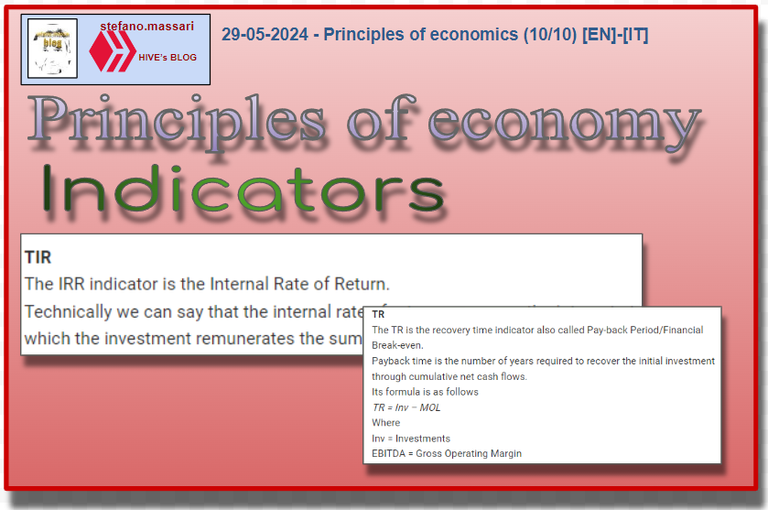29-05-2024 - Principles of economics (10/10) [EN]-[IT]

~~~ La versione in italiano inizia subito dopo la versione in inglese ~~~
ENGLISH
29-05-2024 - Principles of economics (10/10) [EN]-[IT]
Indicators
NPV
The NPV represents the discounted value. It is the algebraic sum of cash flows, discounted at a discount rate that takes into account the opportunity cost of money, over a defined period of time.
We can define it in high terms, saying that the NPV represents the discounted value (discounted at the time of the estimate) of an expected series of positive and negative cash flows (initial investment and annual cash flows) generated by the investment.
The NPV of a given project is more accurate if the cash-flow estimate is rather precise.
In the NPV, cash flows are discounted according to the rate of return, also called opportunity cost because it represents the interest rate of alternative, competing and similar investments that are given up to undertake the project.
TIR
The IRR indicator is the Internal Rate of Return.
Technically we can say that the internal rate of return expresses the interest at which the investment remunerates the sum invested per year of useful life.
TR and IR
TR
The TR is the recovery time indicator also called Pay-back Period/Financial Break-even.
Payback time is the number of years required to recover the initial investment through cumulative net cash flows.
Its formula is as follows
TR = Inv – MOL
Where
Inv = Investments
EBITDA = Gross Operating Margin
IR
IR is the profitability index. This index is also called cost/benefit ratio.
The profitability ratio is given by the Present Value (PV) of expected future cash flows divided by the initial investment.
Its formula:
IR = VA / Inv
Where
PV = Present Value
Inv = Investment
The WACC
The acronym WACC is the weighted average cost of capital and its acronym is the acronym for Weighted Average Cost of Capital.
Basically it is a weighted average between the cost of equity capital and the cost of debt,
Conclusions
After studying the various indicators, it must be kept in mind that the correct financial profile of an investment operation must take into account three factors:
-The amount of monetary flows associated with the investment;
-The temporal distribution of these flows;
-The financial value of time.
Request
Have you ever tried to look for a company's financial ratios to understand its health?

ITALIAN
29-05-2024 - Principi di economia (10/10) [EN]-[IT]
Indicatori
VAN
Il VAN rappresenta il valore attualizzato. Esso è la somma algebrica dei flussi di cassa, attualizzati ad un tasso di sconto che tiene conto del costo opportunità della moneta, in un arco di tempo definito.
Possiamo definirlo con alte parole, dicendo che il VAN rappresenta il valore attualizzato (scontato al momento della stima) di una serie attesa di flussi di cassa positivi e negativi (investimento iniziale e flussi di cassa annuali) generati dall’investimento.
Il VAN di un determinato progetto è più accurato se la stima del cash-flow risulta essere piuttosto precisa.
Nel VAN i flussi di cassa vengono scontati secondo il tasso di rendimento, chiamato anche costo-opportunità perché rappresenta il tasso di interesse di investimenti alternativi, concorrenti e simili ai quali si rinuncia per intraprendere il progetto.
TIR
L'indicatore TIR è il Tasso Interno di Rendimento.
Tecnicamente possiamo dire che il tasso interno di rendimento esprime l’interesse al quale l’investimento remunera la somma investita per anno di vita utile.
TR ed IR
TR
Il TR è l'indicatore del tempo di recupero chiamato anche Pay-back Period/Break-even finanziario.
Il tempo di recupero è il numero di anni necessari per recuperare l’investimento iniziale attraverso i flussi di cassa cumulati netti.
La sua formula è la seguente
TR = Inv – MOL
Dove
Inv = Investimenti
MOL= Margine Operativo Lordo
IR
IR è l'indice di redditività. Questo indice viene chiamato anche rapporto costi/benefici.
L'indice di reddittività è dato dal Valore Attuale (VA) di flussi di cassa futuri previsti diviso l’investimento iniziale.
La sua formula:
IR = VA / Inv
Dove
VA = Valore Attuale
Inv = Investimento
Il WACC
La sigla WACC è il costo medio ponderato del capitale e la sua sigla è l'acronimo di Weighted Average Cost of Capital.
Sostanzialmente si tratta di una media ponderata tra il costo del capitale proprio ed il costo del debito,
Conclusioni
Dopo aver studiato i vari indicatori bisogna tenere presente che il corretto profilo finanziario di un’operazione di investimento deve tenere conto di tre fattori:
-L’ammontare dei flussi monetari associati all’investimento;
-La distribuzione temporale di tali flussi;
-Il valore finanziario del tempo.
Domanda
Avete mai provato a cercare degli indici finanziari di un'azienda per capire lo stato di salute di questa?
THE END
What’s the full meaning of TR and IR?
Io non l'ho fatto, ma dall'attività che svolge l'azienda dove lavoro posso dedurre come sta andando anche a livello economico, mi spiego, l'anno scorso una persona dell'azienda ha rubato una grossa somma di denaro a questa , l'effetto successivo è stato il licenziamento di alcuni colleghi, ora questa persona è in carcere, l'azienda sta superando l'impatto, credo che tu abbia capito cosa intendo